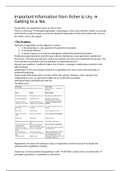Samenvatting
Summary Negotiation and Social Deciscion Making- Getting to a Yes - Fisher&Ury
In this document you'll find the most important information from Getting to Yes (Fisher & Ury), used for the course Negotiation and Social Decision Making at Leiden University, Master Social and Organisational Psychology.
[Meer zien]





